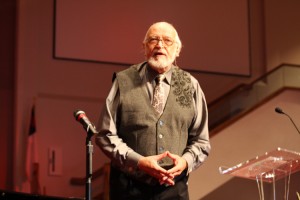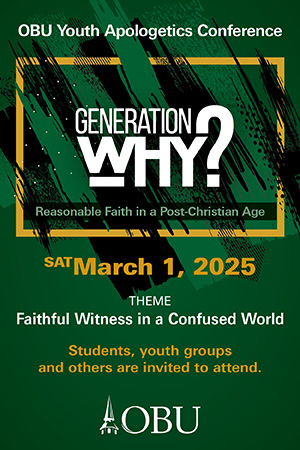 MOORE—Calvin Miller can tell stories. Miller, writer in residence and research professor at Beeson Divinity School in Birmingham, Ala., has the ability to make grown adults feel like children captivated at story time. And his hearers are captivated, not because they are listening to children’s stories, but because they perceive a richness and depth to the story; one senses that within Miller’s narratives are profound truths capable of plumbing the depths of human experience.
MOORE—Calvin Miller can tell stories. Miller, writer in residence and research professor at Beeson Divinity School in Birmingham, Ala., has the ability to make grown adults feel like children captivated at story time. And his hearers are captivated, not because they are listening to children’s stories, but because they perceive a richness and depth to the story; one senses that within Miller’s narratives are profound truths capable of plumbing the depths of human experience.
Not surprisingly, Miller advocated at the 2009 annual meeting of the Baptist General Convention of Oklahoma narrative preaching, that is, story-like preaching. After all, this is how the master-teacher, Jesus, taught. Moreover, the preacher’s text is a story. From the opening words of Genesis to the closing words of Revelation, one is presented with the story of God’s redeeming work in the world. Unlike propositional preaching, which preachers often do, Miller believes that narrative preaching sustains the listener’s attention and leaves indelible marks on the listener’s memory.
Miller calls for sermons to be composed of two parts, didache and kerygma. Didache refers to the content of the sermon. It is derived from the Greek meaning “to teach.” But content alone will not do. The sermon must also bring passion, energy and momentum, that is, it needs to deliver kerygma. These two components of a sermon, didache and kerygma, tend to relate to one another in resistant ways, says Miller. For example, the more didache (content) in a sermon can sometimes suck the life, or kerygma, out of it.
Fittingly, Miller framed his message on preaching around a narrative, the flight of a plane. This metaphor fleshed out Miller’s advice on preaching in a creative way. The flight is made up of three parts: taking off, going somewhere and landing. Of course, the most memorable parts of the flight are the take-off and landing. Accordingly, much attention must be paid to the introduction and conclusion of the sermon. Within the introduction, Miller urges preachers to establish a relationship with the congregation. The preacher must be connected, not aloof.
As for “going somewhere,” the bulk of the sermon must do just that, get somewhere. This is the sermon’s body. Miller encourages preachers to be succinct. He reminds hearers that there are not many bad sermons that are short. Avoid redundancy and verbosity, says Miller. In addition to being lengthy, the body of the sermon can be beset with heavy, intellectual “weather.” In other words, the “flight” (or body) of the sermon should avoid being laden with unintelligible content that causes intellectual turbulence. Finally, sermons should avoid boring flight entertainment (i.e. boring content). These are the perils that might plague the body of the sermon.
The conclusion of the sermon is where the pastor “lands the plane.” Miller calls for the conclusion to be carefully planned, even scripted. There must also be careful application of the sermon. This means the conclusion must answer the “why” of the sermon, says Miller.
Stories can be powerful. This is especially true of The Story. Miller’s plea is for preaching that illuminates this story of God’s restorative efforts in the world.
Casey S. Shutt is a Senior Writer for the Baptist Messenger.





